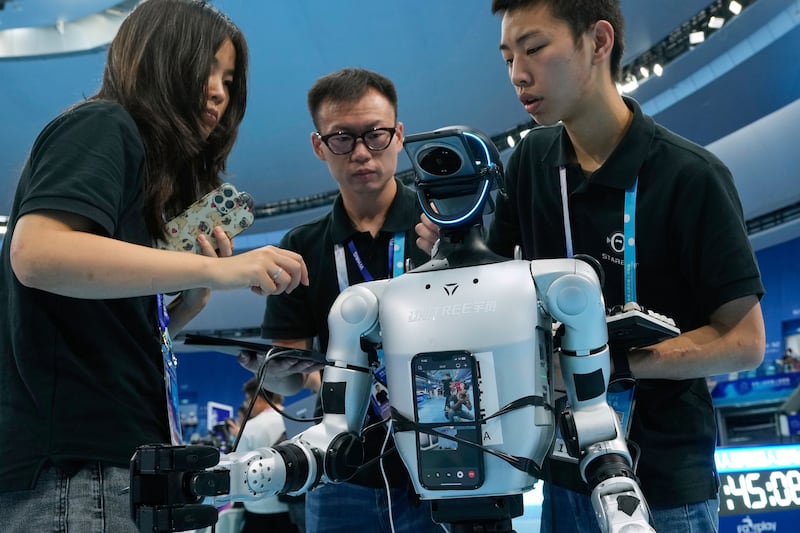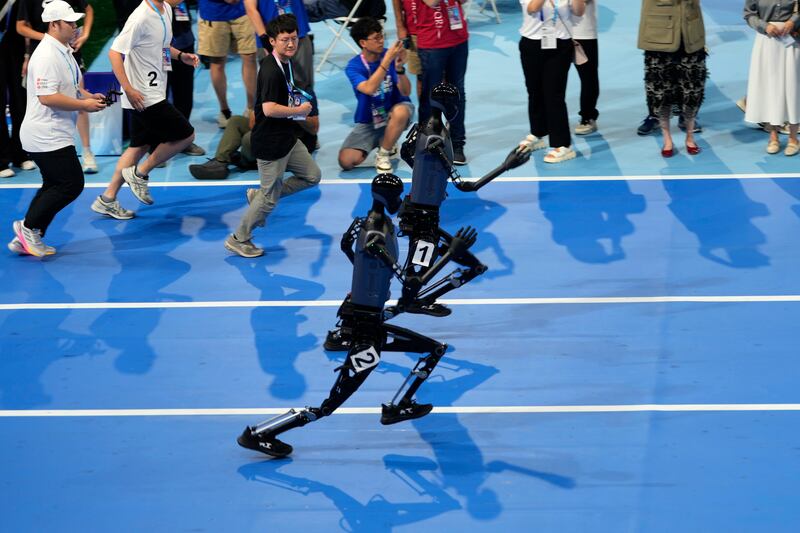- Some 500 humanoid robots competed in the first-ever World Humanoid Robot Games.
- Events included soccer, kickboxing, track and field and more.
- Industry watchers say the humanoid bot market could hit $5 trillion by 2050.
Over 500 robots squared off on soccer fields, running tracks, ping-pong tables and more in Beijing over the weekend in the first ever World Humanoid Robot Games.
The U.S., Germany and Brazil were among the 16 countries represented by 280 teams, from both private industry and universities, that pitted advanced, bipedal machines in an array of competitive sports scenarios as well real-world settings like performing office duties and housekeeping tasks.

Video of the competitions revealed a wide array of competencies as well as some glaring foibles in an event aiming to showcase China’s advances in artificial intelligence and robotics.
The robot competitors had to meet a long list of criteria including that they “must be self-developed, purchased or leased by the participating teams,” they “must have a trunk, upper limbs, and two feet,” and “should have their own energy sources,” according to a report from Mashable. There were also a handful of event-specific rules, like robots competing in the long jump or high jump couldn’t use elastic or take-off devices.

While some contests, like one soccer match, devolved into a pile of entangled and wriggling bots, others showcased impressive and highly athletic skills from the machines which were, in many cases, being operated via remote control.
One viral video caught a track-running robot veering off course and knocking down a spectator and then, seemingly unfazed, rejoining the race.
“Despite the pratfalls, significant progress in robot locomotion and balance is being achieved including backflips, sideflips, and other acrobatic and martial arts moves,” Ken Goldberg, a robotics professor at the University of California, Berkeley, told the New York Times.
StarBot, a California-based tech company that specializes in developing robots skilled in customer service, told NBC News they were “really excited” to be part of the games.
“We thought it was a really good opportunity to come to China and be in an environment where everything is so modern and up to date,” company representative Gregorio Velasco said.
StarBot’s machines are built on the Chinese-made Unitree platform and competed in service-related races as they excel at restaurant scenarios such as taking orders and delivering food to tables, according to Velasco.
Going forward, he said, “we hope to be in people’s homes and restaurants, hotels, and I think in the future, many people will have robots involved in their life.”
So, when can you have your own humanoid robot?
While humanoid robots have been showing up in a variety of mostly promotional settings, like Tesla’s Optimus robots serving drinks at a company event last October, the fast-evolving technology is poised for more serious and widespread deployments, according to industry watchers.
A May report from Morgan Stanley predicts humanoid robot adoption will accelerate in the coming decades and could number a billion by 2050 amid a market acceleration to $5 trillion, driven primarily by use in commercial and industrial applications.
“Adoption should be relatively slow until the mid-2030s, accelerating in the late 2030s and 2040s,” Adam Jonas, Morgan Stanley’s Head of Global Autos and Shared Mobility Research, said in the report.
By 2050, about 90% of humanoid bots, or about 930 million units, will likely be used for repetitive, simple, and structured work — primarily industrial and commercial purposes, according to the report. China is likely to have the highest number of humanoid robots in use by 2050, at 302.3 million, trailed by the U.S. at 77.7 million (up from the previous forecast of 63 million).
But, don’t hold your breath for some version of Rosey, the house-tidying robot from “The Jetsons,” showing up at your local Costco any time soon.
“The forecast for household usage is much more conservative, with only 80 million humanoids in homes by 2050,” Jonas said. “We are not going to see a robot in every home overnight.”


